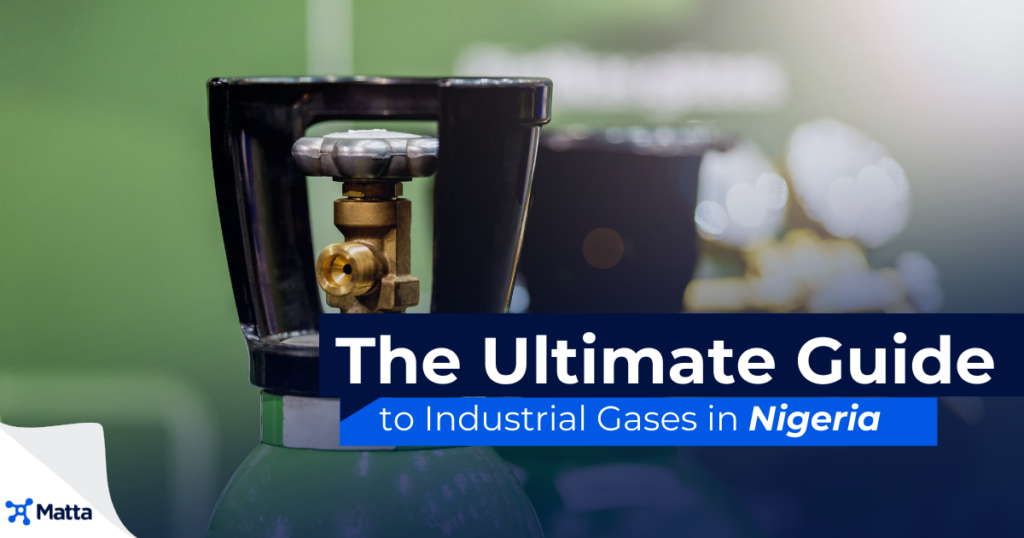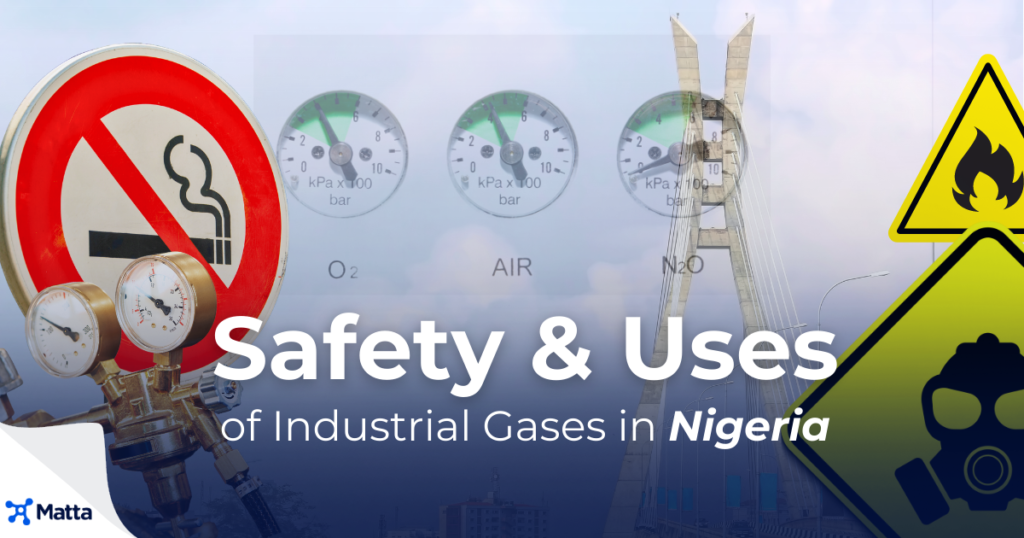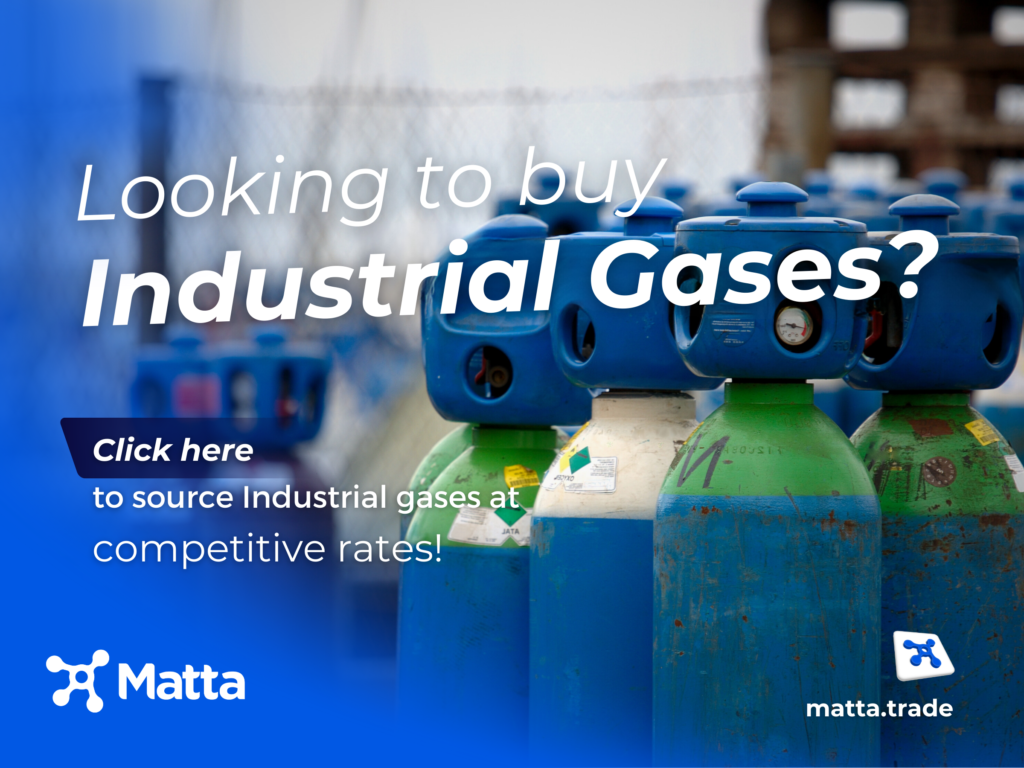
Industrial gases in Nigeria are more than just air; they are specialized gases that undergo rigorous purification processes to meet specific industry standards.
They are essential in processes that require extreme conditions like high temperatures, pressures, or specific chemical compositions. For example, oxygen is used in steel production to facilitate high-temperature processes, while nitrogen is used in food preservation to inhibit bacterial growth.
This comprehensive guide aims to explore this complex and crucial Industry in Nigeria. We will review the history, critical industrial gases, market trends, future outlook, and everything else.
Let’s begin.
What Are Industrial Gases?
Industrial gases are gaseous materials produced for use in various industries. These include Oxygen, Nitrogen, Carbon Dioxide, hydrogen, helium, acetylene, Argon, and many others. Many often confuse industrial gases with natural gases or think of them as compressed air. However, industrial gases in Nigeria are specialized products. They are often mixed, compressed, or liquefied to meet the specific needs of various applications.
Industrial gases are the lifeblood of various sectors, powering everything from healthcare to logistics to lifestyle and manufacturing, to name a few.
Diversification and Specialization
The African Chapter
Fast forward to the mid-20th century. Africa, a continent rich in natural resources but grappling with the complexities of post-colonial economies, started to see the emergence of industrial gases in its industrial landscape. The initial applications were primarily linked to mining activities, especially in countries like South Africa, with a rich mining history.
Industrial Gases in the Nigerian Context
Imagine Nigeria in the early 1960s—a young nation freshly freed from colonial rule, bursting with optimism and untapped potential. The oil boom was just on the horizon, and the country stood at the threshold of an industrial revolution. Amid this transformative period, industrial gases made their debut, paving the way for economic progress.
As the years unfolded, the industrial gas sector began spreading across Africa. Nations like Egypt, Algeria, and Kenya invested in infrastructure, often with international partnerships. In Egypt, gases found applications in healthcare, while Kenya leveraged them for food preservation.
Nigeria, the “Giant of Africa,” refused to be left behind. By the 1960s, the country integrated industrial gases into its oil and gas sector, recognizing their potential not just as a support but as a key driver of industrial growth.
What sets Nigeria’s industrial gas market apart today is the remarkable balance between production and consumption. With an annual output of 200,000 tons, the market responds efficiently to local demand—reflecting both maturity and adaptability in this evolving sector.
Oil and Gas- the Catalyst
Nigeria’s initial industrial gas discovery and commercialization phase was closely tied to the oil and gas sector. Gases like methane were initially flared off as waste products during oil extraction. However, as awareness about environmental sustainability grew, these gases began to be captured and commercialized.
The discovery of oil in Nigeria was a watershed moment, not just for the energy sector but also for ancillary industries. Industrial gases found their initial applications in supporting the oil and gas sector.
If you’re an investor or a stakeholder looking to navigate the complex but promising landscape of Nigeria’s industrial gas sector, you’ve come to the right place. The market has evolved significantly over the past six decades, and understanding its nuances is crucial for making informed decisions.
Market Overview of the Industrial Gas Sector
The Nigerian Industrial Gas industry is medium-scale compared to global markets. However, the industry has shown consistent growth in the last decade. The most recent data shows that the Nigerian industrial gas market is valued at approximately $300 million.
The market was valued at around $150 million a decade ago. This means it has effectively doubled in size over the past ten years, showcasing a Compound Annual Growth Rate (CAGR) of about 7%. Such a growth rate indicates a market that is not only expanding but doing so at a consistent and sustainable pace.
The increasing industrialization and urbanization in the country drive this growth. These serve as dynamic indicators of the market’s growth potential and readiness to attract investment.
Market Trends: The Pulse of the Industry
Trends Impacting Nigeria’s Industrial Gas Sector
Sustainability
Trends come and go, but the global push towards sustainability represents a lasting paradigm shift. In Nigeria, this trend manifests in the increasing demand for eco-friendly gases like hydrogen and helium. Companies that pivot toward sustainable solutions will likely gain a competitive edge, enhancing their market positions.
Technological Advancements
Industry 4.0 technologies, such as automation, IoT, and data analytics, are transforming the industrial gas sector. These advancements facilitate real-time monitoring of gas production, distribution, and consumption, which enhances efficiency and reduces operational costs.
Healthcare Demand
The COVID-19 pandemic served as a global wake-up call for the healthcare sector. In Nigeria, the demand for medical-grade oxygen surged, highlighting gaps in the supply chain. This presents both challenges and significant growth opportunities for industry stakeholders.
Stakeholder Dynamics: The Power Players
Government Agencies
The government primarily regulates the industrial gas industry through agencies such as the Department of Petroleum Resources (DPR) and the National Environmental Standards and Regulations Enforcement Agency (NESREA). The Nigerian National Petroleum Corporation (NNPC) also plays a role in oversight.
Local Producers
Companies like BOC Gases Nigeria and the Nigerian Gas Company serve as the backbone of the industry. While they possess local expertise, these producers often require more capital to invest in cutting-edge technologies.
International Corporations
Global players, including Air Liquide and Linde, have entered the Nigerian market, infusing foreign investment and advanced technology. Their presence enriches the local landscape, fostering innovation and competition.
Investment Opportunities: Where to Place Your Bets
Infrastructure Development: Nigeria’s industrial gas infrastructure requires significant upgrades.
Distribution Networks: Many regions remain underserved; enhancing distribution networks can access new markets.
R&D: Investment in research and development is crucial, enabling the discovery of new applications for industrial gases and unlocking additional sectors and opportunities.
These more profound insights into market trends, stakeholder dynamics, and investment opportunities offer a nuanced understanding of the industrial gas sector in Nigeria. Each aspect presents challenges and opportunities, making a well-informed strategy crucial for success.

Key Industrial Gases Produced in Nigeria
This section sheds light on the key industrial gases that dominate the Nigerian market, their applications, and their economic significance.
Oxygen (O₂)
Production:
Oxygen leads Nigeria’s industrial gas production due to its broad applications in healthcare and manufacturing.
Consumption:
The healthcare sector is the top consumer, using medical-grade oxygen in surgeries and emergency care. Additionally, the manufacturing sector relies heavily on oxygen for processes like steel production.
Economic Significance:
With oxygen contributing around 30% to the total market valuation, it serves as a cornerstone of Nigeria’s industrial gas sector.
Nitrogen (N₂)
Production:
Nitrogen ranks second in production, thanks to its inert properties that make it essential for preservation and storage.
Consumption:
The food and beverage industry uses nitrogen extensively for packaging and preservation, while the oil and gas sector relies on it for safe storage and transport of crude oil.
Economic Significance:
Accounting for 25% of the market valuation, nitrogen plays a crucial role in Nigeria’s industrial landscape.
Carbon Dioxide (CO₂)
Production:
Carbon dioxide production is driven primarily by demand from the food and beverage sector for carbonation.
Consumption:
The beverage industry dominates CO₂ usage for carbonating drinks, but it also finds applications in fire extinguishers and refrigeration systems.
Economic Significance:
CO₂ contributes approximately 15% to the market valuation, underscoring its importance across industries.
Specialty Gases
Production:
Specialty gases—like helium, argon, and acetylene—are produced in smaller quantities but offer higher profit margins.
Consumption:
These gases serve various sectors: helium supports MRI machines in healthcare, acetylene facilitates welding, and argon plays a role in scientific research through spectroscopy.
Economic Significance:
Despite lower production volumes, specialty gases contribute around 10% to the market valuation, thanks to their premium pricing.
Sectors in Need: Industries Relying on Industrial Gases in Nigeria
For stakeholders looking to invest or expand in Nigeria’s industrial gas market, understanding the sectors in dire need of these gases is crucial. This section aims to provide a comprehensive overview of the industries that are significant consumers of industrial gases in Nigeria.
Healthcare
Need for Gases:
Medical-grade oxygen is essential for surgeries, emergency care, and respiratory treatments.
Market Share:
Healthcare contributes nearly 30% of the industrial gas market, positioning it as a critical sector for investment.
Manufacturing
Need for Gases:
Oxygen, acetylene, and nitrogen play crucial roles in welding, cutting, and chemical synthesis processes.
Market Share:
Manufacturing accounts for around 25% of the industrial gas market, presenting significant growth opportunities.
Food and Beverage
Need for Gases:
Nitrogen preserves packaged food, while carbon dioxide enables beverage carbonation.
Market Share:
This sector represents about 20% of the market, with rising consumer demand driving future growth.
Oil and Gas
Need for Gases:
Specialized gases support drilling, refining, and the safe storage and transportation of crude oil.
Market Share:
The oil and gas sector comprises roughly 15% of the industrial gas market.
Environmental Services
Need for Gases:
Gases like sulfur hexafluoride insulate high-voltage equipment, although eco-friendly alternatives are being explored due to environmental concerns.
Market Share:
This sector holds a smaller share but offers niche opportunities for sustainable innovations.
Major Producers and Production Volumes
Understanding the major producers and consumers in Nigeria’s industrial gas market is vital for any stakeholder. This section aims to provide a comprehensive overview of these key players.
Major Producers
BOC Gases Nigeria
- Profile: A leading manufacturer and distributor of industrial gases in Nigeria.
- Market Share: Holds approximately 20% of the market.
- Sustainability Initiatives: Actively investing in eco-friendly gases like hydrogen.
Nigerian Gas Company
- Profile: A Nigerian National Petroleum Corporation (NNPC) subsidiary focusing on gas production.
- Market Share: Accounts for around 15% of the market.
- Specialization: Primarily produces gases for the oil and gas sector.
Air Liquide Nigeria
- Profile: A global player with a significant presence in Nigeria.
- Market Share: Holds about 10% of the Nigerian market.
- Innovation: Known for technological advancements in gas production.
Challenges and Opportunities in Nigeria’s Industrial gas sector.
Challenges in Nigeria’s Industrial Gas Sector
Regulatory Hurdles
Issue: Complex regulations can slow down production and increase costs.
Impact: This affects both local and international players, making market entry and expansion difficult.
Infrastructure Gaps
Issue: Inadequate production and distribution facilities hinder operations.
Impact: These gaps lead to supply chain inefficiencies and increased operational costs.
Market Fragmentation
Issue: The market is fragmented, with many small players.
Impact: This fragmentation makes it challenging to achieve economies of scale and hampers market consolidation.
Opportunities in Nigeria’s Industrial Gas Sector
Technological Advancements
Prospect: Investment in technology can revolutionize production and distribution.
Impact: This shift can lead to cost savings and increased market share.
Sustainability Initiatives
Prospect: The global push for sustainability opens opportunities for eco-friendly gases and practices.
Impact: Companies adopting sustainable methods can gain a competitive edge and access new markets.
Private Sector Involvement
Prospect: Increased private sector investment can drive innovation and market growth.
Local Production: With abundant natural resources, there is potential for enhanced local production, reducing costs.
Export: Neighboring countries could serve as potential markets, creating avenues for export.
Technological Innovations: Embracing new technologies can significantly improve efficiency and production capabilities.
Factors Affecting Demand and Supply of Industrial Gases in Nigeria
Understanding the factors that affect demand and supply is crucial for any stakeholder in Nigeria’s industrial gas sector. This section aims to shed light on these key determinants.
Factors Affecting Demand
Economic Growth
- Influence: A growing economy increases industrial activity, thereby boosting demand for industrial gases in Nigeria.
- Current Status: Nigeria’s focus on industrialization is likely to sustain demand.
Technological Advancements
- Influence: New technologies can create additional uses for industrial gases in Nigeria, increasing demand.
- Current Status: Automation and IoT are opening new avenues for gas applications.
Healthcare Needs
- Influence: Medical emergencies and healthcare infrastructure drive the demand for medical-grade gases.
- Current Status: The COVID-19 pandemic has significantly increased the oxygen demand.
Factors Affecting Supply
Production Capacity
- Influence: The ability to produce sufficient quantities affects the supply chain.
- Current Status: Infrastructure gaps remain a challenge, affecting supply reliability.
Regulatory Environment
- Influence: Regulations can either facilitate or hinder production.
- Current Status: Complex regulations are currently a bottleneck for many producers.
Distribution Networks
- Influence: Efficient distribution is crucial for meeting demand.
- Current Status: Inefficiencies in distribution networks often lead to supply chain disruptions.
Market Segmentation for Industrial Gases in Nigeria
Along what lines are markets facing in the industrial gases in Nigeria market? By understanding this, we can understand the impact of the trends as mentioned earlier and all other factors considered.
Understanding the various segments within Nigeria’s industrial gas market is beneficial and essential for targeted marketing, product development, and investment decisions. This section dissects the market into manageable categories based on multiple parameters.
By Type of Gas
Oxygen
- Market Share: Holds about 30% of the market.
- Applications: Primarily used in healthcare for surgeries and emergency care, and in manufacturing for processes like welding.
- Consumer Profile: Hospitals, steel mills, and automotive manufacturers.
Nitrogen
- Market Share: Accounts for approximately 25% of the market.
- Applications: Used extensively in food preservation and in the oil and gas sector for safe storage and transport of crude oil.
- Consumer Profile: Food and beverage companies, oil and gas firms.
Specialty Gases (Helium, Argon, Acetylene)
- Market Share: Collectively make up about 10% of the market.
- Applications: Used in niche sectors like healthcare (helium for MRI machines), welding (acetylene), and research (argon for spectroscopy).
- Consumer Profile: Research institutions, healthcare facilities, and specialized manufacturing units.
By End-User Industry
Healthcare
- Market Share: Consumes nearly 30% of all industrial gases.
- Key Gases: Medical-grade oxygen nitrous oxide for anesthesia.
- Growth Drivers: Aging population, increased healthcare infrastructure.
Manufacturing
- Market Share: Contributes around 25% to the industrial gas market.
- Key Gases: Oxygen, acetylene, argon.
- Growth Drivers: Industrialization policies, foreign investments.
Food and Beverage
- Market Share: Accounts for about 20% of the market.
- Key Gases: Nitrogen for food preservation, carbon dioxide for carbonation.
- Growth Drivers: Rising consumer demand for packaged and processed foods.
By Geography
Lagos
- Market Share: Contributes around 40% to the overall market.
- Key Industries: Manufacturing, healthcare.
- Opportunities: High population density and industrial growth.
Port Harcourt
- Market Share: Makes up approximately 25% of the market.
- Key Industries: Oil and gas, shipping.
- Opportunities: Strategic location and access to international markets.
Other Regions
- Market Share: The remaining 35% is spread across various states.
- Opportunities: Untapped markets, potential for localized production facilities.
By Distribution Channel
Direct Sales
- Market Share: Accounts for about 50% of sales.
- Consumer Profile: Large-scale industrial consumers.
- Challenges: Requires robust logistics and supply chain management.
Retail
- Market Share: Makes up around 30% of sales.
- Consumer Profile: Small and medium enterprises, individual consumers.
- Challenges: Inventory management, retail margins.
Online
- Market Share: Currently a small segment but growing.
- Consumer Profile: Tech-savvy consumers, small businesses.
- Opportunities: E-commerce growth, wider reach.
Final Thoughts
The industrial gas market in Nigeria presents a complex yet rewarding landscape filled with opportunities and challenges. This guide offers a comprehensive overview of its history, types, and market dynamics, paving the way for investors and consumers.
Looking ahead, sustainability and green technologies, such as hydrogen as a clean fuel, shape the industry’s future. From early chemists to today’s high-tech facilities, industrial gases have evolved significantly, playing an integral role in various sectors and daily life.
With the right knowledge and strategy, this market can offer lucrative ventures for those willing to navigate its complexities.
FAQs
1. What Are Industrial Gases?
Industrial gases in Nigeria are specially made for various industrial applications, from healthcare and manufacturing to food preservation.
2. What Are the Key Types of Industrial Gases Produced in Nigeria?
- The key types include oxygen, nitrogen, and specialty gases like helium, argon, and acetylene.
3. Which Sectors Are Major Consumers of Industrial Gases?
- The primary consumers are the healthcare, manufacturing, and food and beverage sectors.
4. What Are the Challenges Facing the Industrial Gas Market in Nigeria?
- Regulatory hurdles, infrastructure gaps, and market fragmentation are some of the main challenges.
5. Are There Investment Opportunities in the Market?
- Opportunities exist in technology, sustainability initiatives, and increased private-sector involvement.
6. How Does Matta’s Marketplace Fit Into This Landscape?
- Matta offers a platform that connects buyers and sellers in the industrial gas sector, streamlining the sourcing and selling process.
7. What Factors Affect the Demand and Supply of Industrial Gases In Nigeria?
- Economic growth, technological advancements, and healthcare needs affect demand, while production capacity, regulatory environment, and distribution networks influence supply.
8. How Is the Market Segmented?
- The market is segmented by gas type, end-user industry, geography, and distribution channel.
9. What Role Does Sustainability Play in the Market?
- Sustainability is becoming increasingly important, offering opportunities for eco-friendly gases and practices.
10. How Can I Get Involved in the Market?
- Exploring Matta’s chemical marketplace is a great starting point for sourcing or selling industrial gases in Nigeria.



